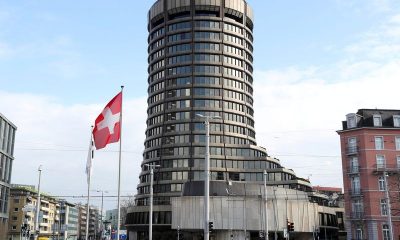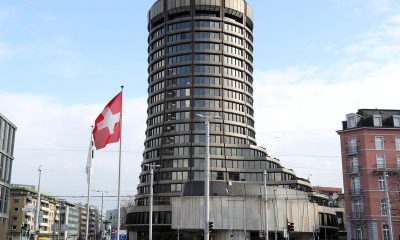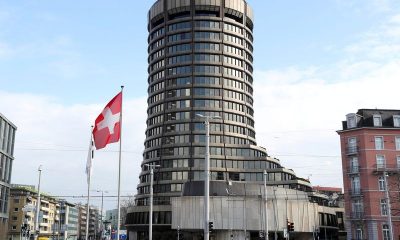Economy
ECB Preview: What do experts expect?

This week, investors’ attention is focused on central bank meetings. In the case of the European Central Bank, forecasts point to a 25 basis point (bp) hike.
Germán García Mellado, fixed income manager at A&G said that a 25bp hike seems pretty much discounted for this meeting leaving the deposit facility at 3.5% and the main refinancing operations at 4.0%. He added that, in turn, it should pave the way for another additional quarter percentage point hike in July.
García Mellado further explains that they will have to see the positioning between now and then, as, according to statements from Governing Council members, opinions are sharply divided on whether or not they will implement another additional increase at the turn of the summer. He adds that, in any case, the market is already partly pricing in this possibility (three hikes from current levels), so it would have a moderate impact on bond valuations.
Kevin Thozet, a member of Carmignac’s investment committee, notes in an e-mailed commentary that although the European monetary tightening cycle started four months after the Fed’s, without major setbacks, it is making itself felt.
For him, the level of inflation remains high (6.3% in Germany and 5.1% in France for total year-on-year inflation). These levels require constant vigilance. 5% is a particularly important threshold, associated with a greater homogeneity of price increases between goods and services and a stronger linkage with wages. He added that the rigidity of the European labor market is also leading to greater inertia on the wage front, which is growing at a rate of 5% year-on-year.
More and more hikes?
Many experts not only predict a rate hike at this June meeting, but also venture that the agency could continue to raise interest rates at future meetings.
García Mellado adds that, what is practically certain is that the Monetary Authority will continue with the message of going ‘meeting by meeting’ to leave all possibilities open in the face of the data that will be published.
Thozet concludes that it is also likely that at the July meeting the European monetary institution will raise its deposit rates by 25 basis points, possibly for the last time if the disinflationary trend is confirmed. He adds that, in this regard, Christine Lagarde has (so far) managed to complete her monetary tightening cycle without any cracks materializing in the system, despite the fact that a year ago it was said that the region was the least prepared to face a tightening cycle.
Ruben Segura-Cayuela, chief economist for Europe at Bank of America adds, “We expect a 25bp hike from the ECB this week, with a message of more to come. The ECB is likely to be vague on whether that means one or several additional hikes; there is little pressure or need for such a signal this week. Forecasts are likely to continue to feed divisions, with higher near-term core but medium-term inflation at target.”
The prospect of a pause on the part of the ECB is thus receding. In fact, according to a recent report by Japanese bank Nomura, the ECB will not cut rates until the fourth quarter of 2024. According to them, Lagarde has stated many times that the ECB does not stand still, in contrast to the Fed, and that the ECB still has some way to go.
Economy
Russian central bank says it needs months to make sure CPI falling before rate cuts -RBC


© Reuters. Russian Central Bank Governor Elvira Nabiullina attends a news conference in Moscow, Russia June 14, 2019. REUTERS/Shamil Zhumatov/File Photo
MOSCOW (Reuters) – Russia’s central bank will need two to three months to make sure that inflation is steadily declining before taking any decision on interest rate cuts, the bank’s governor Elvira Nabiullina told RBC media on Sunday.
The central bank raised its key interest rate by 100 basis points to 16% earlier in December, hiking for the fifth consecutive meeting in response to stubborn inflation, and suggested that its tightening cycle was nearly over.
Nabiullina said it was not yet clear when exactly the regulator would start cutting rates, however.
“We really need to make sure that inflation is steadily decreasing, that these are not one-off factors that can affect the rate of price growth in a particular month,” she said.
Nabiullina said the bank was taking into account a wide range of indicators but primarily those that “characterize the stability of inflation”.
“This will take two or three months or more – it depends on how much the wide range of indicators that characterize sustainable inflation declines,” she said.
The bank will next convene to set its benchmark rate on Feb. 16.
The governor also said the bank should have started monetary policy tightening earlier than in July, when it embarked on the rate-hiking cycle.
Economy
China identifies second set of projects in $140 billion spending plan


© Reuters. FILE PHOTO: Workers walk past an under-construction area with completed office towers in the background, in Shenzhen’s Qianhai new district, Guangdong province, China August 25, 2023. REUTERS/David Kirton/File Photo
SHANGHAI (Reuters) – China’s top planning body said on Saturday it had identified a second batch of public investment projects, including flood control and disaster relief programmes, under a bond issuance and investment plan announced in October to boost the economy.
With the latest tranche, China has now earmarked more than 800 billion yuan of its 1 trillion yuan ($140 billion) in additional government bond issuance in the fourth quarter, as it focuses on fiscal steps to shore up the flagging economy.
The National Development and Reform Commission (NDRC) said in a statement on Saturday it had identified 9,600 projects with planned investment of more than 560 billion yuan.
China’s economy, the world’s second largest, is struggling to regain its footing post-COVID-19 as policymakers grapple with tepid consumer demand, weak exports, falling foreign investment and a deepening real estate crisis.
The 1 trillion yuan in additional bond issuance will widen China’s 2023 budget deficit ratio to around 3.8 percent from 3 percent, the state-run Xinhua news agency has said.
“Construction of the projects will improve China’s flood control system, emergency response mechanism and disaster relief capabilities, and better protect people’s lives and property, so it is very significant,” the NDRC said.
The agency said it will coordinate with other government bodies to make sure that funds are allocated speedily for investment and that high standards of quality are maintained in project construction.
($1 = 7.1315 renminbi)
Economy
Russian central bank says it needs months to make sure CPI falling before rate cuts -RBC


© Reuters. Russian Central Bank Governor Elvira Nabiullina attends a news conference in Moscow, Russia June 14, 2019. REUTERS/Shamil Zhumatov/File Photo
MOSCOW (Reuters) – Russia’s central bank will need two to three months to make sure that inflation is steadily declining before taking any decision on interest rate cuts, the bank’s governor Elvira Nabiullina told RBC media on Sunday.
The central bank raised its key interest rate by 100 basis points to 16% earlier in December, hiking for the fifth consecutive meeting in response to stubborn inflation, and suggested that its tightening cycle was nearly over.
Nabiullina said it was not yet clear when exactly the regulator would start cutting rates, however.
“We really need to make sure that inflation is steadily decreasing, that these are not one-off factors that can affect the rate of price growth in a particular month,” she said.
Nabiullina said the bank was taking into account a wide range of indicators but primarily those that “characterize the stability of inflation”.
“This will take two or three months or more – it depends on how much the wide range of indicators that characterize sustainable inflation declines,” she said.
The bank will next convene to set its benchmark rate on Feb. 16.
The governor also said the bank should have started monetary policy tightening earlier than in July, when it embarked on the rate-hiking cycle.

 Forex3 years ago
Forex3 years agoForex Today: the dollar is gaining strength amid gloomy sentiment at the start of the Fed’s week

 Forex3 years ago
Forex3 years agoUnbiased review of Pocket Option broker

 Forex3 years ago
Forex3 years agoDollar to pound sterling exchange rate today: Pound plummeted to its lowest since 1985

 Forex3 years ago
Forex3 years agoHow is the Australian dollar doing today?

 Cryptocurrency3 years ago
Cryptocurrency3 years agoWhat happened in the crypto market – current events today

 World3 years ago
World3 years agoWhy are modern video games an art form?

 Commodities3 years ago
Commodities3 years agoCopper continues to fall in price on expectations of lower demand in China

 Economy3 years ago
Economy3 years agoCrude oil tankers double in price due to EU anti-Russian sanctions



























